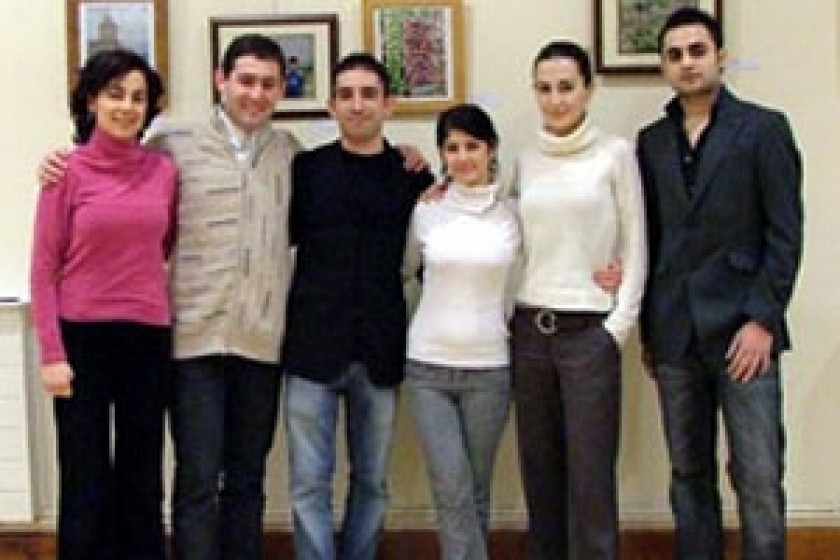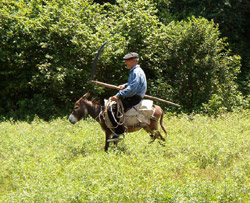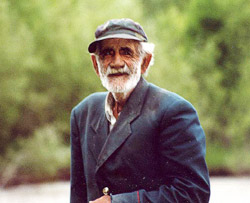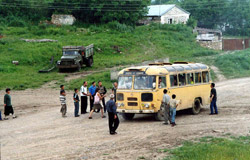
Armenians in London
Hasmik Hovhannisian
Mihran Sahakyan
The morning train is bringing us - me, Martin and Haniel to London. Martin and Haniel are my English friends. More precisely, Martin is an Englishman and his wife, Haniel has a mixture of French, Greek and Armenian blood.
It is Sunday morning and we are going to an Armenian photographic exhibition. It is hard to say who is more excited - I, who besides being an Armenian is also a participant to the exhibition, or they.
It's a year that I've been here, in England, without anything Armenian, and now I myself am like a foreigner going to reveal Armenia through the photos. An interesting feeling.
London is splendid, picturesque and noisy. The exhibition is in the Gulbenkian Hall. This name suggests a big, light gallery situated in a building like those around me.
Nothing of the kind. We are entering a small yard in Kensington and there surrounded by English buildings is a tiny white Armenian church and next to the church there is a small one story building. That is Gulbenkian hall.
It is 11 am and the liturgy is on in St. Sarkis Church. It is Haniel's first time at an Armenian liturgy; she starts making parallels between the Greek and Armenian liturgies.
While they are listening to the liturgy I am wandering in the city a bit. Not far from St. Sarkis there is another Armenian Church, St. Heghine. Well, we are Armenians; we cannot be satisfied with one Church. I feel proud and immediately laugh at myself. In Armenia I would criticize the idea of building two churches next to each other but here, outside Armenia, I take this fact as a proof of keeping the nationality and traditions.
 |
 |
When I come back, they are selling some food in the church.
"How much is this?" an old woman is asking in Armenian. I cannot see the price of what she asked about.
"10 golds," replies the salesperson, also an old woman.
I feel as if I am in an old Armenia.
"How old and how long in London are they that still remember golds?" I think to myself, walking to the hall.
The topic of the exhibition is Armenia. Armenian landscapes, Armenians' lives in their fatherland and abroad. About 70 photos depicting nature, people, mountains, monuments are on display. Among the participants are both professional and amateur photographers. The overwhelming majority of both the participant and the visitors are Armenians. The visitors are mostly the people who had come for the liturgy.
 The exhibition is organised by the Armenian Students Association UK. It is taking place for the first time. The organisation itself is not that old. It was created in February 2005 by Armenian students studying in the different universities of London.
The exhibition is organised by the Armenian Students Association UK. It is taking place for the first time. The organisation itself is not that old. It was created in February 2005 by Armenian students studying in the different universities of London.
The organisers say that among the association's goals are to develop a fellowship amongst Armenian students and cultivate a spirit of appreciation towards Armenian culture, history, traditions and heritage.
It is the third and the last day of the exhibition. At 4.00 pm an auction of the photographs begins.
The proceedings will go to an Armenian Children's charity.
Bartosz has raised most money, selling 7 photos for 77 pounds. He gets praise for that.
Bartosz is my friend. He is the one who told me about the exhibition, he himself, by the way, being in his homeland Poland at the time.
Three years ago I got a message in ICQ. A guy from Poland told me that he wanted to visit to Armenia and asked where I would advise him to go and how much it would cost.
I told him, "Come to Armenia, the rest is up to me."
 From Yerevan we, four guys, drove to Nagorno Karabakh through the Lachin corridor and in four days came back to Armenia, to Lake Sevan through the Zod mine.
From Yerevan we, four guys, drove to Nagorno Karabakh through the Lachin corridor and in four days came back to Armenia, to Lake Sevan through the Zod mine.
Moreover, we thought that a visa for 25 dollars that was compulsory for all the foreigners visiting Nagorno Karabakh was too expensive and Bartosz traveled throughout Karabakh without a visa.
When they would stop us at customs we would say that the offices in Stepanakert were already closed or if they did not approach the car we would say there were only Armenians in the car.
On the way back we decided to no longer test our luck. We hid Bart's very long blond hair under a cap and switched on Tata music on the highest volume. Bart was moving his head to right and left just like Tata does. After this who would suspect a foreigner in our car?
That was three years ago. And now Bart's photos made in Armenia and Karabakh are on display in London, in the Armenian exhibition.
Martin buys one of Bart's photos.
"It seems to me I visited Armenia," he says. "I knew Armenia was beautiful but did not imagine to this extent!"
Martin and Haniel are going to visit Armenia in spring, for the first time.
The photo Martin bought Bart made in Karabakh. There is an old yellow bus on it with green trees behind. There is a small crowd of people around the bus. Martin tells me what attracted him in the picture.
"It is not clear if the people are getting on or off, or even if there is space on the bus. What it does show is people getting on with their lives, as part of an unknown, unwritten journey. "
In the evening we are moving back to Nottingham. It is dark outside the train windows. Haniel has got a liturgy song from the church and carries on revealing the differences between the Armenian and Greek churches. She liked the way the pastor in an Armenian church gives the communion: kneels down before the communicant and nevertheless is higher than him or her because he is on the altar.
I am listening to her and thinking of the words of the deacon in St. Sarkis Church. He told me that Bart could have had Armenian roots. That in the 15th -17th centuries during Tsarist times several Armenian families were forced to move to Poland and there had to change their family names. And one of those families which probably had the surname Musayelyan changed it to Musialovicz. That is Bartosz's surname.
"When we get to Nottingham I will write to him," I think to myself. "He will be glad; he likes Armenia so much."
 Videos
Videos Photos
Photos
Write a comment